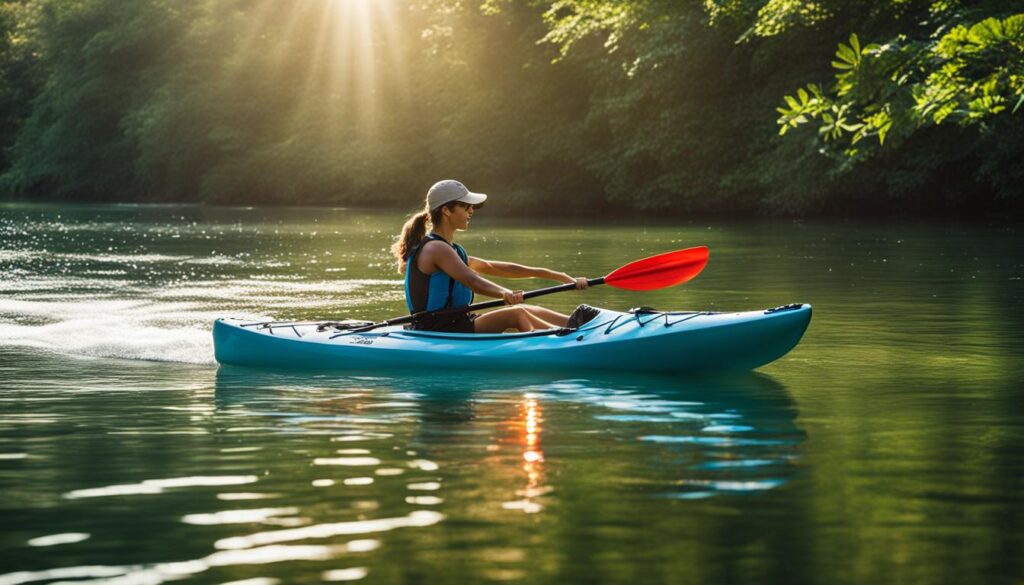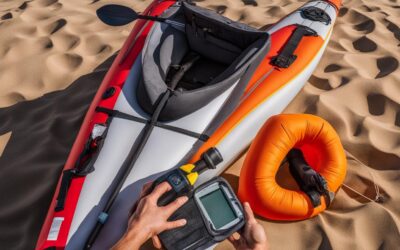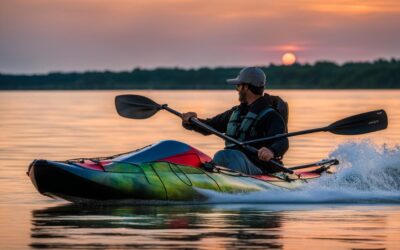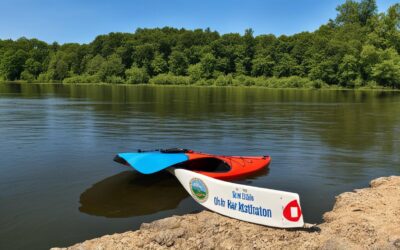Kayaking is a popular outdoor activity that not only allows you to connect with nature but also provides an excellent workout. If you’re wondering how many calories you can burn while kayaking, you’ve come to the right place. In this article, we’ll explore the calorie-burning potential of kayaking and discuss its benefits as a workout.
Key Takeaways:
- Kayaking can burn approximately 375 – 475 calories per hour, depending on factors like body weight and exercise intensity.
- It offers a full-body workout, engaging muscles in the back, shoulders, arms, chest, and core.
- In addition to burning calories, kayaking provides cardiovascular benefits and helps increase overall fitness and endurance.
- The calorie burn in kayaking is comparable to activities like surfing, biking, swimming, and paddleboarding.
- To increase calorie burn, focus on using proper paddling technique, challenging yourself with more difficult waters, and paddling for longer durations.
The Benefits of Kayaking as a Workout
Kayaking is not only a fun and exciting way to explore the waters, but it also offers numerous fitness benefits. Whether you’re looking to lose weight, increase your overall fitness level, or just enjoy a new outdoor activity, kayaking can be a great option. Here are some of the key benefits of kayaking as a workout:
1. Kayaking for Weight Loss
If you’re aiming to shed some pounds, kayaking can be an effective way to burn calories and support weight loss. Paddling through the water requires a significant amount of energy, engaging various muscle groups in your body. As you paddle, you’ll be using your arms, shoulders, back, and core, which can help tone and strengthen these areas. Additionally, kayaking is a low-impact activity, making it suitable for individuals of all fitness levels.
2. Kayaking as a Full-Body Workout
Kayaking provides a full-body workout that targets multiple muscle groups simultaneously. The constant paddling motion works your arms, shoulders, chest, and upper back. Your core muscles, including your abs and obliques, are engaged as you stabilize and balance yourself in the kayak. Additionally, your legs and lower body play a role in maintaining stability and providing power during each stroke. This comprehensive workout can help improve overall strength, endurance, and flexibility.
3. Calorie Expenditure and Cardiovascular Benefits
Engaging in kayaking for extended periods can result in a significant calorie burn. The intensity of your paddling, along with factors such as your weight and the speed of the water, can influence the number of calories you burn during each session. Additionally, kayaking is a cardiovascular exercise that gets your heart rate up and improves your cardiovascular endurance. Regular kayaking can contribute to a healthier heart and help reduce the risk of cardiovascular diseases.
Overall, kayaking provides a unique opportunity to combine exercise with the great outdoors. Not only will you enjoy the natural beauty of your surroundings, but you’ll also reap the many physical benefits kayaking offers. Whether you’re paddling on calm lakes or tackling challenging rivers, kayaking can be an excellent addition to your fitness routine.
Factors Affecting Calorie Burn in Kayaking
When it comes to calorie burn in kayaking, there are several factors that can influence the number of calories you’ll burn during your workout. These factors include your body weight, exercise intensity, duration of the activity, and the difficulty of the water or terrain. Let’s take a closer look at how each of these factors can affect your calorie burn.
Body Weight
Your body weight plays a role in determining how many calories you’ll burn while kayaking. Generally, the more you weigh, the more calories you’ll burn because it takes more energy to move a heavier body. So if you’re looking to maximize your calorie burn, carrying a few extra pounds may actually work in your favor.
Exercise Intensity
The intensity of your kayaking workout also affects the number of calories you’ll burn. The more effort you put into each stroke and the faster you paddle, the more calories you’ll expend in a given period of time. So if you want to increase your calorie burn, try to maintain a brisk pace and challenge yourself with more intense paddling.
Duration and Difficulty
The duration of your kayaking session and the difficulty of the water or terrain can also impact your calorie burn. Naturally, the longer you paddle, the more calories you’ll burn. Additionally, paddling in rougher waters or against a current requires more effort and can lead to a higher calorie expenditure. So consider extending your paddling session or exploring more challenging routes to amp up your calorie burn.
Comparison of Kayaking Calorie Burn to Other Activities
Kayaking can be a relatively effective calorie-burning activity compared to other forms of cardio exercise. While the exact calorie burn will depend on factors such as body weight, exercise intensity, duration of the activity, and the difficulty of the water or terrain, kayaking can burn approximately 375 – 475 calories per hour.
When compared to other popular activities, kayaking holds its own in terms of calorie burn. Here is a comparison of kayaking calorie burn to other activities:
- Surfing: While both kayaking and surfing involve water sports, kayaking typically burns more calories. Surfing burns around 250 – 350 calories per hour.
- Biking: Biking is a popular outdoor activity that can also burn a significant amount of calories. On average, biking burns around 350 – 600 calories per hour, depending on factors such as speed and terrain.
- Swimming: Swimming is a low-impact exercise that provides a full-body workout. It can burn approximately 400 – 600 calories per hour, making it comparable to kayaking in terms of calorie burn.
- Paddleboarding: Paddleboarding is another water sport that engages the core and upper body muscles. It burns around 400 – 500 calories per hour, similar to kayaking.
While these numbers are estimates, they give an idea of how kayaking compares to other activities in terms of calorie burn. Keep in mind that individual calorie burn may vary depending on factors specific to each person.
Kayaking vs. Other Activities: Which is Better for Calorie Burn?
When it comes to choosing the best activity for calorie burn, it ultimately depends on personal preference, fitness goals, and accessibility to equipment and facilities. Kayaking offers a unique combination of calorie burn, full-body workout, and outdoor enjoyment. It can be a great option for those who enjoy being on the water and want a low-impact, yet effective cardio exercise.
If your primary goal is calorie burn, you may opt for activities such as biking or swimming, which can burn slightly more calories per hour. However, it’s important to choose an activity that you enjoy and can stick to in the long run. Consistency and regularity in exercise are key for reaching and maintaining fitness goals.
Tips for Increasing Calorie Burn in Kayaking
If you’re looking to maximize your calorie burn while kayaking, there are several strategies you can implement. By incorporating these tips into your kayaking routine, you can increase the intensity of your workout and burn more calories.
Paddling Technique
Using the correct paddling technique can make a significant difference in calorie expenditure. Focus on engaging your core and upper body muscles with each stroke. Use your shoulders, back, and arms to power the paddle through the water, and maintain a steady rhythm. By using proper form and technique, you’ll ensure that you’re getting the most out of each stroke and increasing your calorie burn.
Challenging Waters
Kayaking in more challenging waters, such as rivers with a faster current or rougher waves, can intensify your workout and help you burn more calories. Navigating through these conditions requires more effort and strength, which leads to a higher calorie expenditure. However, it’s essential to ensure you have the necessary skills and experience to handle these conditions safely.
Adding Resistance
Adding weight to your kayak can increase the resistance and make your muscles work harder, resulting in a higher calorie burn. You can carry additional gear or equipment in your kayak, such as weights or sandbags, to add resistance. Just make sure to distribute the weight evenly and maintain proper balance to ensure a safe and enjoyable kayaking experience.
Longer Durations and Upstream Paddling
Paddling for longer durations and against the current (upstream) can also help increase your calorie burn. By extending your kayaking sessions, you’ll spend more time engaged in physical activity and burn more calories overall. Paddling against the current adds an extra challenge and requires more effort from your muscles, resulting in additional calorie expenditure.
By implementing these tips, you can elevate your kayaking workout and maximize your calorie burn. Remember to start slowly and gradually increase the intensity of your kayaking sessions to prevent overexertion and ensure a safe and enjoyable experience. Happy paddling!
Kayaking as a Form of Cardio and Strength Training
When it comes to fitness, kayaking is a versatile activity that offers both cardio and strength training benefits. It engages various muscle groups in the body, providing a full-body workout while also raising the heart rate for cardiovascular conditioning. Whether you’re paddling through calm waters or tackling more challenging rapids, kayaking can help you achieve your fitness goals.
The Benefits of Kayaking as Cardio Training
Kayaking is an excellent form of cardio exercise that can improve your overall fitness. As you paddle, your heart rate increases, allowing for better cardiovascular conditioning. This can lead to improved endurance, stamina, and a stronger cardiovascular system. Regular kayaking sessions can help you burn calories, boost your metabolism, and improve your lung capacity.
The Strength Training Benefits of Kayaking
In addition to cardio, kayaking also provides effective strength training for various muscle groups. The repetitive paddling motion engages the muscles in your back, arms, shoulders, chest, and core. Over time, this can lead to increased muscle strength, improved muscle tone, and enhanced overall body stability. Kayaking can also help improve your posture, as it requires proper body alignment and core engagement.
Overall Fitness with Kayaking
By combining cardio and strength training, kayaking offers a holistic approach to fitness. It not only enhances your physical health but also provides mental and emotional benefits. Being out in nature while paddling can reduce stress, promote relaxation, and uplift your mood. So, whether you’re looking to improve your cardiovascular health, strengthen your muscles, or simply enjoy the outdoors, kayaking is a rewarding activity that can contribute to your overall fitness.
The Mental and Physical Benefits of Kayaking
Kayaking not only provides a great workout for your body, but it also offers numerous mental health benefits. Spending time on the water and enjoying nature has a calming and therapeutic effect on the mind, helping to reduce stress and promote relaxation. The rhythmic motion of paddling can be a form of meditation, allowing you to clear your mind and find mental clarity.
In addition to stress relief, kayaking can improve your overall mood and well-being. Being surrounded by nature, breathing in fresh air, and soaking in the beauty of your surroundings can boost your mood and increase feelings of happiness and contentment. The peaceful and serene environment of the water can provide a much-needed escape from the hectic pace of everyday life.
Kayaking can also be a social activity, allowing you to connect with others who share a similar interest. Joining a kayaking club or group can provide a sense of community and support, and sharing the experience with others can enhance your enjoyment of the activity. Engaging in social interactions while kayaking can also contribute to improved mental health and a sense of belonging.
Physical Benefits of Kayaking:
- Provides a full-body workout, engaging muscles in the back, shoulders, arms, chest, abs, and legs
- Helps to build strength, endurance, and cardiovascular fitness
- Improves flexibility and coordination
- Offers a low-impact exercise option that is gentle on the joints
How Kayaking Can Benefit Mental Health:
- Reduces stress levels and promotes relaxation
- Enhances mood and increases feelings of happiness
- Provides a sense of peace and tranquility
- Allows for mental clarity and reflection
- Offers a social outlet and opportunities for connection
Incorporating kayaking into your fitness routine not only provides physical health benefits but also contributes to improved mental well-being. Whether you’re paddling along a serene lake or riding the waves of the sea, kayaking offers a unique and fulfilling experience that can rejuvenate both your body and mind.
Conclusion
Kayaking is a fantastic activity for both your physical and mental well-being. Not only does it provide a great calorie-burning workout, but it also offers a full-body exercise that engages various muscle groups. Whether you’re paddling in calm waters or taking on challenging rapids, kayaking can help you burn calories and build strength.
In addition to its fitness benefits, kayaking allows you to connect with nature and enjoy the outdoors. Breathing in the fresh air and taking in the beautiful surroundings can have a positive impact on your mood and overall health. It’s a great way to reduce stress, clear your mind, and find relaxation in the midst of nature’s beauty.
Whether you choose to make kayaking your primary form of exercise or incorporate it into your fitness routine as a supplement, it can contribute to your overall health and well-being. So grab your kayak, paddle out into the water, and let the physical and mental rewards of kayaking enhance your fitness journey.
FAQ
How many calories does kayaking burn?
Kayaking can burn approximately 375 – 475 calories per hour, depending on factors such as body weight, intensity, duration, and water difficulty.
What muscles does kayaking work?
Kayaking engages muscles in the back, shoulders, arms, triceps, biceps, forearms, grip, chest, and abs, providing a full-body workout and helping to build strength in these areas.
How does kayaking compare to other activities in terms of calorie burn?
Kayaking is comparable to activities such as surfing, biking, swimming, and paddleboarding in terms of calorie burn.
How can I increase the calorie burn while kayaking?
You can increase the calorie burn by using proper paddling technique, paddling in challenging waters, adding weight to the kayak, kayaking upstream, and extending the duration of your workout.
Is kayaking cardio or strength training?
Kayaking can be both a cardio and strength training activity, as it raises the heart rate and provides a cardiovascular workout while also working various muscle groups in the body.
What are the mental and physical benefits of kayaking?
Kayaking can reduce stress, improve mental clarity, provide a sense of relaxation and enjoyment, and offer physical benefits such as cardiovascular fitness, strength, and endurance.










